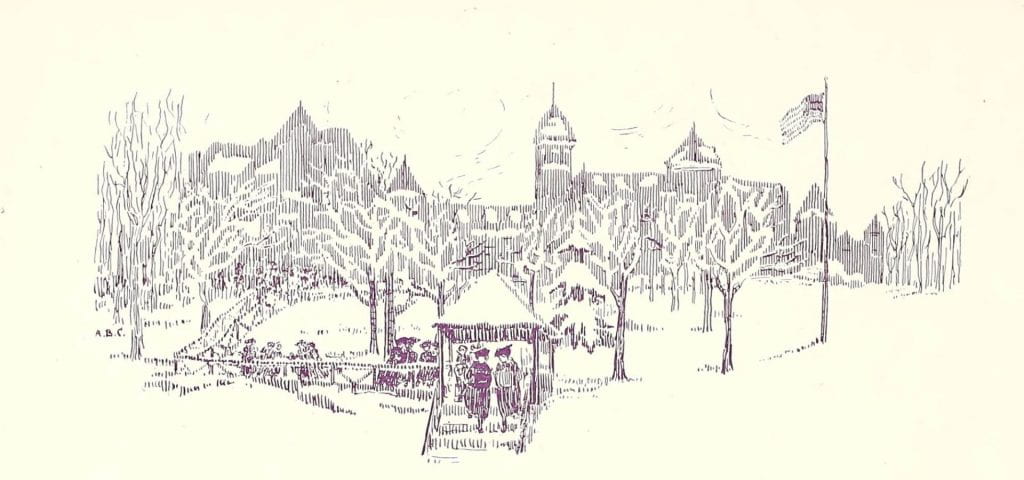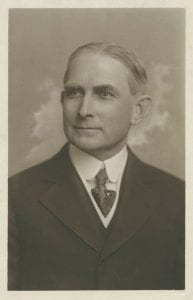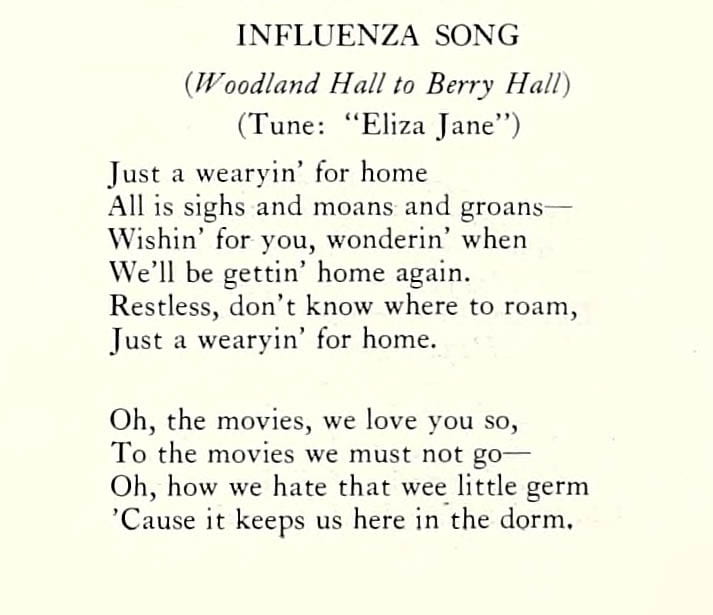In the midst of the worldwide COVID-19 pandemic, members of the Chatham community are responding to the current threat and are comforted by an understanding that our current situation is temporary. This broad perspective is supported by the history of public health emergencies and the realization that this is not the first time that Chatham has responded to a global influenza pandemic through proactive distancing measures. Similar closures occurred in the fall of 1918.
The 1918 influenza pandemic, the most severe pandemic in modern history, reached into all corners of the world. Over 17 million people worldwide and 675,000 in the United States lost their lives due to the virus and one third of the world’s population become infected. Pittsburgh, where widespread economic disparity had many workers living in crowded boarding houses, was one of the hardest hit cities in the country with a mortality rate twice the national average during the worst days of the pandemic.
On October 4, 1918, PA State Commissioner of Health Dr. B. F. Boyer ordered that every place of public amusement (poolrooms, dance halls, theaters, saloons) be closed and a city-wide quarantine for Pittsburgh was announced the next day. Reports from across the country appeared in the local papers detailing the closings of colleges and Universities, sporting and entertainment event cancellations, and a rapid increase in the number of influenza victims in much the same manner as we’ve seen in recent weeks. The Pennsylvania College for Women (PCW, now Chatham University) suspended classes amid this environment of rapid infection spread.
Despite the impact the 1918 pandemic had on the city population, campus publications from the time spare little space for discussion of the school’s closing or the epidemic itself. College President Acheson, in reporting to the Alumnae Association in the Alumnae Recorder May 1919 issue, simply states “Early in the session we were compelled to close the college for one month on account of the influenza epidemic” before providing an overview of enrollment, plans for campus expansion, and the 50th anniversary celebration planned for 1920. The Alumnae Association, in their report, mentions that their regular fall meeting was held in November instead of October and that “the postponement being due to the influenza epidemic and the consequent prohibition of public meetings.” Sue Riddle Paine, member of the class of 1894, is mentioned for her time spent “nursing in the slums during the influenza epidemic.” The first post-pandemic issue of the Alumnae Recorder is otherwise filled with updates about alumnae activities including employment, war work, and family along with discussion of the anniversary celebration and student clubs.
Student publications of the era, such as the student newspaper and yearbook, similarly include little mention of the pandemic. Where it is mentioned, the tone is markedly different from discussions about the COVID-19 pandemic occurring today. For example, the Fall 1918 Sorosis student newspaper includes an editorial titled “Vacation” that describes one student’s dismay at being required to continue her studies while the school was closed. She writes,
Usually vacations are times of great rejoicing looked forward to for weeks ahead, and planned for with all the ingenuity possible. And so, the surprising announcement which came so unexpectedly, so entirely without warning on that Tuesday morning, “College closes today for an indefinite period” was greeted with great enthusiasm by many. The aforementioned enthusiasm received a chill, however, when the enthusiasts went to classes and heard such heartless assignments as “Finish first book in Economics” or, in International Law, “Prepare next six chapters and know important international conferences up to date.” In other words, “Keep studying and you’ll not have time to entertain influenza germs.
The piece continues with a discussion about how all students should maintain their focus on coursework so that planned Christmas and Easter vacations will not be cancelled. The 1919 yearbook’s “Senior Class History” includes the remark that “The first semester was broken up by the enforced flu vacation, so things had to be done in double-quick time.” Again here, the author refers to the closure of the school to combat the spread of the virus as a “vacation.”
Historians contend that we must consider records and primary sources within the context of their creation and, from that context, to gather a broader sense of the perspective being presented. Considered within the context of the public health disaster of the 1918 pandemic, what can be learned from the statements of the PCW president, alumnae, and students? Does the treatment of the pandemic in these printed sources indicate carelessness or disregard in the face of so many deaths? Or, could other events have shaded the statements we see in these sources?
Consider the calendar printed in the 1919 yearbook shown below. The influenza pandemic is mentioned alongside a variety of activities relating to World War I.
These and other records in the University Archives describe the Social Work program at Chatham, which was the first of its kind in the country. How might the war work and the emphasis on social work explain the minimal discussion of the influenza?
Examining primary sources can raise lots of questions and can inspire avenues of research that span across repositories, document types, and record formats. In continuing to explore the local impact of the 1918 influenza pandemic, what other sources could be helpful? How might one explore the differences between the 1918 pandemic and the 2020 pandemic on campus and in the region? What other questions might come up in the process?
Curious for more? Here are a few links the include discussion of the 1918 pandemic:
Pennsylvania College for Women 1919 & 1920 yearbook (click here)
Sorosis student newspaper, 1918-1921 (click here)
Alumae Recorder, 1916 – 1923 (click here)
National Museum of Health and Medicine Virtual Exhibit, “Closing in on a Killer: Scientists Unlock Clues to the Spanish Influenza Virus” (click here)
Pennsylvania Historical & Museum Commission, 1918 Influenza Epidemic Records (click here)
Online lecture about how steel corporations impacted death rate in Pennsylvania during the 1918 pandemic by Jim Higgins, via National Museum of Industrial History (click here)
Online lecture about the 1918 pandemic titled “Pittsburgh: Steel City, Industry, and the 1918 Influenza Pandemic” by Jim Higgins, via National Museum of Industrial history (click here)
“When the Spanish Flu Swept In, Pittsburgh Failed the Test,” Bill O’Toole, Pittsburgh Quarterly (click here)
“Records reveal 1918 influenza’s devastating impact on a tiny Pittsburgh community,” The Digs, Post-Gazette (click here)
“Pittsburgh didn’t confront the 1918 epidemic in time,” Brian O’Neill, Pittsburgh Post Gazette, 3/19/20 (click here)







March 25, 2020 at 9:29 am
Very interesting work by Molly Tighe. I knew little about the 1918 pandemic except that my grandparents died Of that flu, leaving five children behind, the youngest only an infant. They were poor—lived on Pittsburgh’s North Side and probably had never heard of Chatham College. They were taken in and raised by kind aunts and uncles, and as a result, had the opportunity to get college educations and pursue successful careers. Thanks for this information.
March 25, 2020 at 2:16 pm
What an amazing story, Susan. Thank you so much for sharing. Your story really drives home how impactful the 1918 flu was to so many families in the region.
April 16, 2020 at 9:44 am
Thank you for this informative article. My family lived in Western Massachusetts and they were not particularly impacted by the flu. At least not that I every heard. I doubt many of us knew much about the flu epidemic except in specific context of the effect on one person or group of persons such as soldiers. Actually, I have read more about it in terms of the slums of England than in reference to the U.S. Certainly I have never read about it as it pertained to the Pittsburgh area.
April 17, 2020 at 10:16 am
Hi Mary, Thanks for your comment! I’d never researched it before now, either, but it really is quite a fascinating bit of history. I just added a couple new references to the list for further reading and you might enjoy them. The lecture about the 1918 pandemic in Pittsburgh and the piece in the Pittsburgh Quarterly were particularly enlightening for me. Hope you are well! Stay safe!
Molly